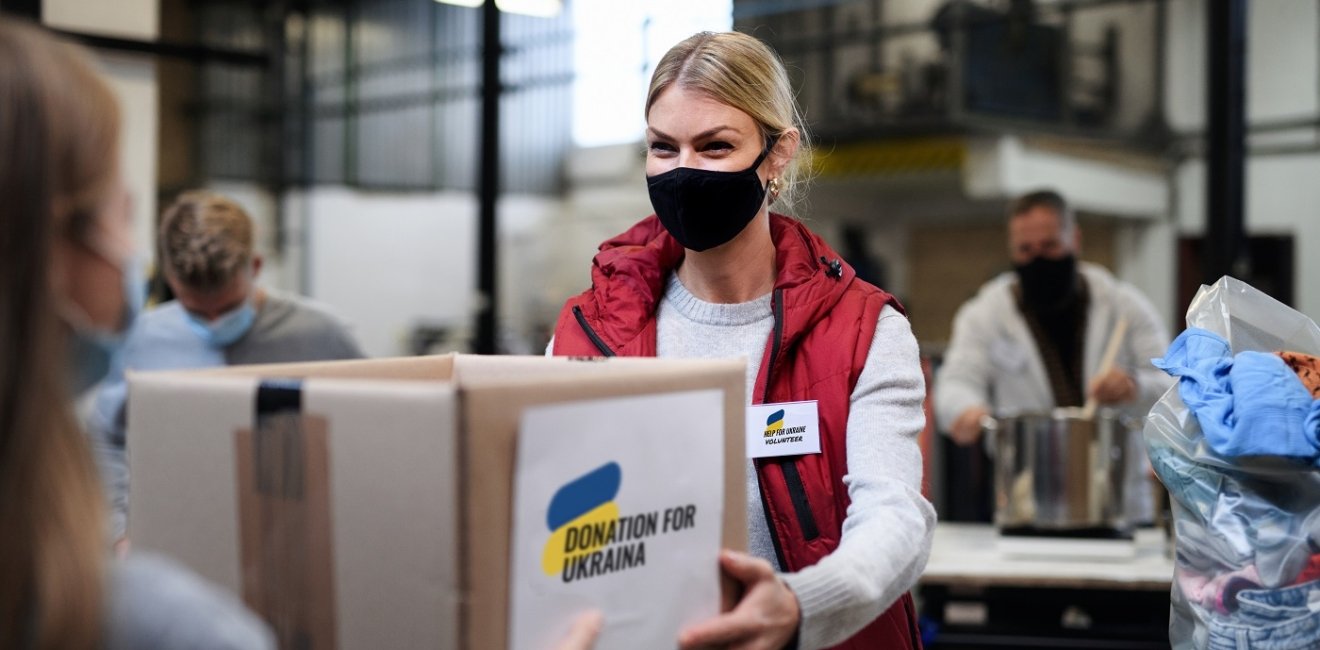
A blog of the Kennan Institute
Local NGOs in Ukraine are much more effective than big international aid organizations like ICRC and UN, so let them access international aid money
International humanitarian organizations receive billions of dollars to help Ukraine (for instance, the UN collected more than $2.24 billion), but in reality, the aid comes too slow and doesn’t fit people’s real needs.
When Russia invaded Ukraine in February, Ukrainian activist Olena Shevchenko turned to international organizations for help. She runs two NGOs. Insight supports the rights of LGBTQ+ people, and Women's March advocates for women's rights in Ukraine. Before the invasion, these organizations were focused on small communities that were actively fighting for their rights. But the Russian invasion changed all that. The target audience of these organizations has grown to half of Ukraine's population, from women to children. Shevchenko says that gaining support from large, international organizations for her work has proved to be the most difficult challenge has ever faced.
Shortly before the invasion and in the early days of the attack, most of the major humanitarian aid agencies evacuated staff from Ukraine and frantically searched for local replacements. Meanwhile, hundreds of thousands of people across the country were in mortal danger. Some tried to evacuate from cities that Russia attacked, like Mariupol, Kherson, or Bucha. Others tried to travel to European Union territory across the western border. At least 16 million Ukrainians found themselves temporarily displaced, inside and outside of their country. Supplies to Ukraine, of food, hygiene products, and other necessities, were interrupted, and a humanitarian crisis erupted in many cities. It was necessary to react to what was happening and to seek resources quickly.
Shevchenko says that in the first two months of the invasion, international organizations such as the UN, Doctors Without Borders, or the International Committee of Red Cross did not respond to numerous requests. She had to use personal contacts to find aid for people affected by Russia's actions, and it was primarily friends and volunteers from Ukraine and European countries who quickly responded to requests for help.
"It took two months to establish communication with medium-sized donors and just start talking to the big ones,” Shevchenko says. “For them, responding quickly is something impossible. I saw a different reality: I was asked to fill out an Excel spreadsheet indicating needs. We were doing this 24/7: collecting lists, proofreading, translating—and we got nothing in two months. You send them the needs, and they cut it all,” she said, so that “instead of 5,000 units of diapers, you only get 10 packs."
In June, the research initiative Humanitarian Outcomes published a report, Enabling the Local Response: Emerging Humanitarian Priorities in Ukraine, March–May 2022, critical of how international humanitarian organizations responded to the invasion and requests from the Ukrainian population. According to the report, for the first six weeks post-invasion, virtually all humanitarian aid inside Ukraine was organized and implemented by local actors, including around 150 preexisting national NGO, and church groups, and around 1,700 newly formed local aid groups. “These groups (together with local authorities), remain the principal aid providers but are quickly being exhausted of funds, fuel, and physical energy,” the report says (page 3).
Local communities, activist initiatives, churches and religious organizations, as well as city and village councils under local administrations, played a major role in the rapid response. They were able to quickly find the necessary aid for people who needed support and organized deliveries. They delivered even to the occupied territories, despite the high risks—the Russian army shelled dozens of centers where humanitarian aid was distributed, and Russian soldiers shot at volunteers and vehicles carrying local humanitarian groups.
The way this works can be seen on the ground. For example, after the liberation of the Kyiv, Sumy, and Chernihiv oblasts from the Russian occupiers, local communities and volunteers promptly began restoring destroyed homes and transporting humanitarian aid to the population, which was collected with the help of local entrepreneurs and private donors. Volunteers have traveled and continue to travel to the occupied territories, helping people get out of places that are being shelled and bringing in humanitarian aid. International missions are not represented in most such regions. Some of these groups, the Humanitarian Outcomes report says, have contacts in the diaspora that provide them with money and access to other private donors, and some volunteers make regular trips outside of Ukraine (e.g., to Poland and Romania) to find new donors and purchase goods that are difficult to obtain in the regions where they work.
According to the report, the majority of humanitarian aid funding to Ukraine is concentrated in the hands of UN entities and the ICRC, while local organizations account for only 6 percent of that funding, At the same time, the operational presence of local organizations and volunteer groups is greater than that of international organizations in similar proportions. Local organizations know what people need, and they know how to manage the aid through the communities they serve, but international organizations do not want to cooperate or to give them funding.
Oleksandra Matviychuk, head of the Center for Civil Liberties, one of the two NGOs that just won this year’s Nobel Peace Prize, documents human rights violations in Ukraine and war crimes. She believes that the main problem is that major international organizations act according to the old molds and do not want to change. The structure of organizations such as the UN or the ICRC is hierarchical and often ignores the local context. The field staff is usually seen as a functional unit, tasked with carrying out instructions from above, and the opinions of these staff members are not taken into account in decision-making.
This attitude is vividly illustrated, for example, by the situation that occurred with Amnesty International. When the organization published an unbalanced report in August, “Ukrainian Fighting Tactics Endanger Civilians,” the Ukrainian team denounced this approach, and local AI leader Oksana Pokalchuk stated that during the preparation of the report, the central office ignored numerous comments from the Ukrainian team that could have balanced the report without distorting the real situation. She then resigned, along with part of the local team.
"International NGOs evacuated their staff at the beginning of the invasion, when we needed them,” says Matviychuk. “Ordinary Ukrainians had to fight their way through. The rules and procedures of international organizations replaced their mission. Humanitarian aid is needed right here and now,” she said, and “you have to take responsibility and break procedures to fulfill the mission—to save people. This requires leadership. There are wonderful people working on the ground in these organizations who understand why it is important and understand the mission, but they are led by people who are sharpened to procedures. And these procedures are not designed for such a crisis in which Ukraine found itself."
In March, Matviychuk initiated an open appeal to international organizations to return to Ukraine and help Ukrainians cope with the unprecedented attack on humanity in the center of Europe. This appeal went unanswered. In March, tens of thousands of people could not leave surrounded or Russian-occupied territories because the Russian side did not agree to give a "green corridor.” Negotiations for a green corridor, through which civilians can pass unhindered to escape from the shelling, are usually conducted by organizations such as the ICRC and the OSCE, but they proved powerless. In Mariupol, Kherson, and Bucha, for example, there were no representatives of these international organizations—they had all evacuated before or at the beginning of the invasion, while the trapped Ukrainian citizens were counting on them.
Ukrainian volunteers and activists continue to work nonstop to cover the needs of fellow citizens suffering from Russia's attack. Shevchenko says demands on her two NGOs have not lessened. In months of negotiations with international organizations about possible coordination efforts that would help ease the burden of local volunteers, little has changed.
Now, she says, major humanitarian missions have developed a program of micro-grants for Ukrainian NGOs aimed at trainings for the population. "People are asking for food, medicine, hygiene, and you have to tell them—come to the training and we will tell you how to be more capable in a situation of war," Shevchenko says. "I believe that we need to break the system and build a new one. We have to start from the needs. Local organizations have lists of needs that are constantly updated. International humanitarian missions could contact us and ask what people really need, based on real requests."
Matviychuk also believes that humanitarian missions need to change and make their rules more flexible for a crisis of the scale that Ukraine is experiencing.
She would also like to see a change in how people are hired for senior positions in such organizations. "We need people who are focused on the mission, not on rules and procedures," Matviychuk said. "I do not see such people there now. I see them ‘at the bottom.’ We need to change the rules and procedures so that they allow initiative—risk—because there is no change without risk.” She added, “although I criticize international organizations a lot for this, it is because I believe in international law, and I want them to change for the better. Because we desperately need them."
The opinions expressed in this article are those solely of the author and do not reflect the views of the Kennan Institute.
Author


Kennan Institute
The Kennan Institute is the premier US center for advanced research on Eurasia and the oldest and largest regional program at the Woodrow Wilson International Center for Scholars. The Kennan Institute is committed to improving American understanding of Russia, Ukraine, Central Asia, the South Caucasus, and the surrounding region through research and exchange. Read more

Explore More in Focus Ukraine
Browse Focus Ukraine
Talking to the Dead to Heal the Living

Ukrainian Issue in Polish Elections


